#yoshihiro mori
Explore tagged Tumblr posts
Photo



ボクたちはみんな大人になれなかった [We Couldn't Become Adults] (Yoshihiro Mori, 2021)
#drama film#passionate#Japan#Japanese movies#lifetime#ボクたちはみんな大人になれなかった#Yoshihiro Mori#Buddha#We Couldn't Become Adults#Mirai Moriyama#Sairi Ito#joy#Masahiro Higashide#Sumire#Takehiro Hira#revelation#life#Atsushi Shinohara#Moemi Katayama#Amane Okayama#gioia#Masanobu Takashima#relationships#2020s movies#romance#Far east cinema#memories#friendship#happiness#aging
10 notes
·
View notes
Text
We Couldn't Become Adults ボクたちはみんな大人になれなかった (2021) Director: Yoshihiro Mori
We Couldn’t Become Adults ボクたちはみんな大人になれなかった 「Bokutachi wa Minna Otona ni Narenakatta」 Release Date: November 05th, 2021 Duration: 124 mins. Director: Yoshihiro Mori Writer: Ryo Takada (Script), Moegara (Original Novel), Starring: Mirai Moriyama, Sairi Itoh, Masahiro Higashide, Sumire, Yuko Oshima, Amane Okayama, Atsushi Shinohara, Website IMDB Two 40-somethings, a graphics designer and a…
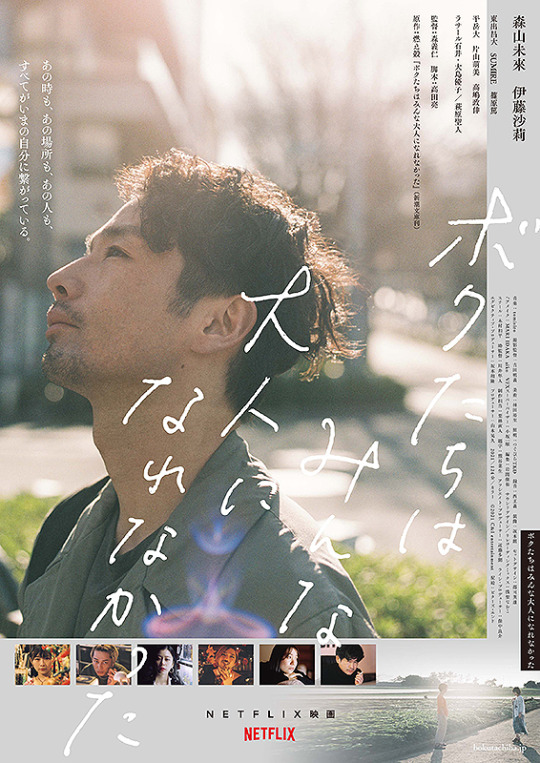
View On WordPress
#Amane Okayama#ボクたちはみんな大人になれなかった#Japanese Film#Japanese Film Review#Masahiro Higashide#Mirai Moriyama#Sairi Itoh#Sumire#We Couldn&039;t Become Adults#Yoshihiro Mori#Yuko Oshima
0 notes
Text
BL doujin & Men Who Make Some of Them
If BL is stories of androphilic men by androphilic women, then what’s the opposite of that? It would probably be stories of androphilic women by androphilic men.
The latter is what Minamoto Kazuki mainly dabbles in.
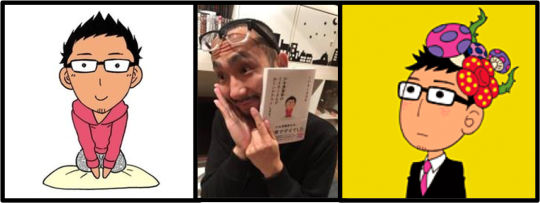
Apart from straight & BL manga, he also authored Shoujo Manga Artist Minamoto-San Comes Out. Yeah, that’s the title. It is autobiographical if that wasn’t obvious. Arguably, his most famous manga, at least in BL fandom, is Wall Circle's Doujin Artist Nekoyashiki-Kun's Desire for Recognition Grows which got live-action adaptation: KabeKoji in 2022.
Androphilic male characters who create straight content is not rare in BL. In 2023, from what I can recall, we got two such characters: Sung Woo Jae from Individual Circumstances (2023) and Yoh from Taikan Yoho (2023). Jinta from Cherry Magic (2023) also writes (presumably straight) romance. Even before that, we got an entire BL live-action franchise (starting with The Novelist (2018)).
Doujin production and consumption
Doujinshi (doujin for short) is self-published works. It includes both derivative works (fan works) as well as original works. It is estimated that nearly half of the doujin produced and circulated are BL. These are traditionally sold at conventions like Comiket. These days doujin are sold online, for example through dedicated websites like DL site.
Doujinshi culture and Comiket especially has been instrumental in the development of BL as a genre. Unfortunately, unlike other BL pioneers such as Mari Mori (her 1961 novel A Lovers' Forest is considered the first BL) and the Year 24 Group, Meikyu doujin circle (Yoshihiro Yonezawa in particular) seldom find mention in history of BL.
BL doujin grew side by side with commercially published works. The original use of the portmanteau yaoi (no peak, no fall, no meaning) was an indication of plot what plot nature of those doujins that subverted the East Asian narrative structure to focuse exclusively on erotic relations. Doujin BL varied widely in themes and approaches, even more than commercial BL as doujin are not created to appeal to the masses, instead cater to super-specific fandoms. Also, it is easier to debut into doujin arena than to commercial BL. However, since these are literally ‘thin books’ in most cases, there is associated limitation. There is cost of printing to be taken into account as well.
As more explicit doujin (yaoi) and less explicit BL (shonen ai, etc.) coevolved in a porous environment, BL transformed into a successful genre in itself with numerous dedicated magazines and multimedia adaptations. Moreover, doujin was good ground for experimentation and yields in that arena made its way into mainstream BL and enriched it.
Commercial BL welcomed many doujinshika into its fold. e.g. Ayano Yamane (author of the Finder series) is associated with a bunch of doujin circles at different points in time: GUN MANIA, Shouhoku Taiiku Yougushitsu and Ouka Seisaku.
BL mangaka continued producing both doujin and commercial BL. e.g. Kizu Natsuki (author of Given) is a prolific doujinshika under the name Gusari in Sashikizu circle.
BL mangaka produced doujin of their own work. e.g. Ichikawa Kei (author of Blue Sky Complex) published erotic extras as doujin.
These days, there is pixiv among others and long serialization possibilities. Authors are less constrained by space – unlike physical publication, web publication is not constrained by real estate (number of pages, chapters, etc.). Thanks to the internet, the distance between doujin and commercial BL have shortened.
A lot of gei comi (bara) is also self-published.
Doujin BL culture exists everywhere BL is famous with wide variation.
Doujin played an important role in emergence and growth of Korean BL. e.g. Totally Captivated by Yoo Ha Jin had doujin extras.
Chinese doujin culture is slightly different from that in other countries. Note-worthy is the self-publication of danmei (Chinese BL) novels. Three most recent cases against danmei authors [and their accomplices including those who helped the authors print, bind, package and sell those copies] were for self-publication.
天一(Tian Yi) for her student X teacher SM erotica 攻占 (Seize Control) - charged for self-publication and violation of law prohibiting publication of obscenity [explicit SM involving a 17-year-old student and his teacher in the novel]
深海先生 (Mr. Deep Sea) for her historical romance 锁帝翎 (aka 笼中帝 ; The Caged Emperor) - charged for self-publication.
There is a third. But the details are not available in the public domain.
It used to be a common practice for authors to self-publish uncensored versions of their web-published works, sometimes with explicit extras. These were intended for fans who wanted to collect these copies and to express their appreciation to the authors. Both self-publishing and “obscene content” are illegal in China.
Doujin, BL and their creators
Kabe Koji is the journey of a doujinshika, Mamoru Nekoyashiki, who yearns to be recognized as such and also as a beloved. While in high school, he fell in love with his childhood friend Kazama Issei whom he is sure doesn’t like him like that, thanks to rampant compulsory heterosexuality. Being gay was something he felt he had to keep under wraps not only because of fear of rejection but also because of heterosexism. Talented in drawing, he visits Comic King, a popular otaku convention where he discovers a different world – where male androphilia is celebrated in art.
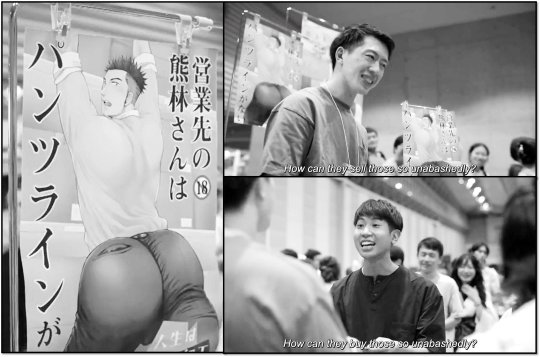
This inspires him to cultivate his talent in drawing and to pursue a career in manga. Since the art he was most drawn in by was ero-manga with macho uke with bitch characteristics, that’s the style he pursues.
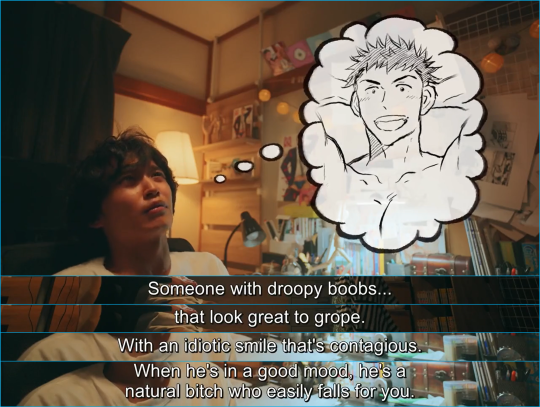
When we meet him, this is the subgenre that we see him focusing on. His influences are pretty obvious.
Moreover, the main character (hence the target of affection in his work) looks a bit like his crush. Issei notices this and tries to draw himself like that (with disproportionately thin neck) in little notes and letters to his Mamocchi.
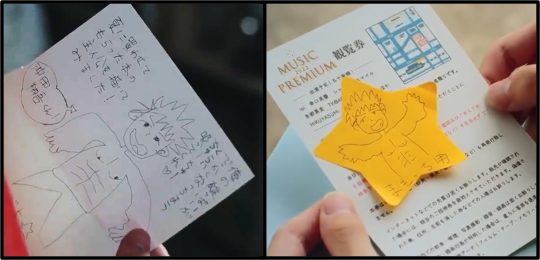
[I honestly think Nakao Masaki was bit of a miscast for this role appearance-wise because in the manga Issei is more on the gacchiri (muscular) side of ikemen. Whoever thought Torii-san’s uke from Fudanshi Bartender no Tashinami (2022) would be right fit for Issei’s character. The actor clearly didn’t disappoint in any other aspect. This is like the case with casting decision in One Room Angel (2023) wherein a manga character with gachimuchi aesthetics was changed into a lean ikemen. An opportunity for a different body-type was wasted. No complains against those actors since they aren’t the ones responsible for casting.] This is an erroneous assessment. Thank you @tompetertrash for correcting me.
Nekoyashiki, while pursuing training and education in manga making, has already established himself as a fairly successful doujinshika known as Honeniku-sensei of Muscle Department Store. He belongs to the Wall Circle.
"Kabe circle" (wall circle) — a slang term for doujin groups or "circles" that are popular enough for their booths to be placed beside the wall of the convention, for ease of line management. (Source: ANN)
He is friends with Yamada, a fujoshi who is his support in creating, defending and selling doujin.
Such friendships are not too rare. For example, friendship between Yoh and Manju in Taikan Yoho (2023). And the IRL friendship between female danmei author Lan Lin and male manhuajia Liang Azha.
Yun SuAn's friend Choi is a BL manhwaga in My Damn Business (2024).
Nekoyashiki meets two other characters at Comic King: Framboise and Takkun.
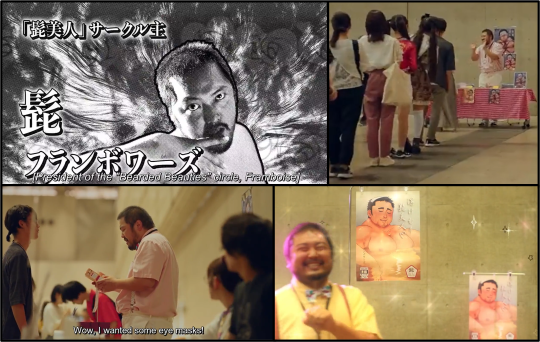
Framboise is the president of a doujin circle called Bearded Beauties. He is very popular. He is not only among the wall circles each time we see him, but also is showered with gifts by his fans. He acknowledges that he has been doujinshika for years. His art resembles him – body-type, facial hair, moe. He keeps inviting Nekoyashiki warmly to a gathering of muscle BL artists despite getting turned down. His interactions with Nekoyashiki are precious.
Takkun is Nekoyashiki’s fan. He is inspired by Nekoyashiki and worked hard to establish himself as a wall circle doujinshika.
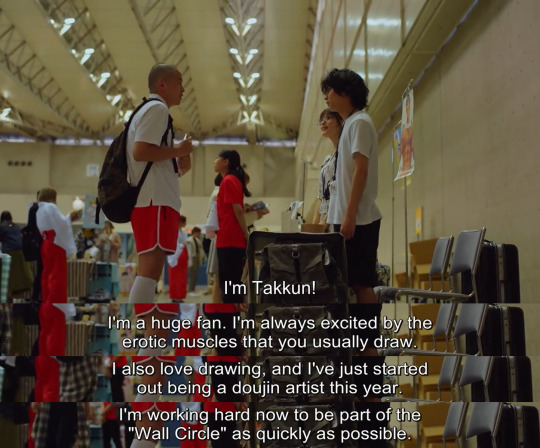
His rise from a consumer to producer of doujin and finally a wall circle doujinshika mirror's Nekoyashiki’s journey. Moreover, his rise is contrasted with Nekoyashiki’s fall.
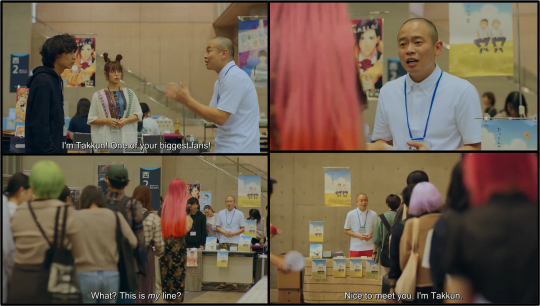
Also, one of two characters on his doujin cover looks a lot like him.
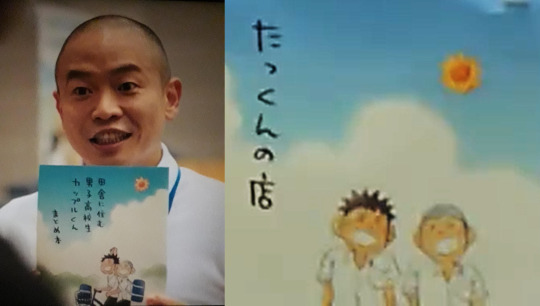
Unlike Framboise and Takkun who draw what they like, Nekoyashiki draws to be recognized.
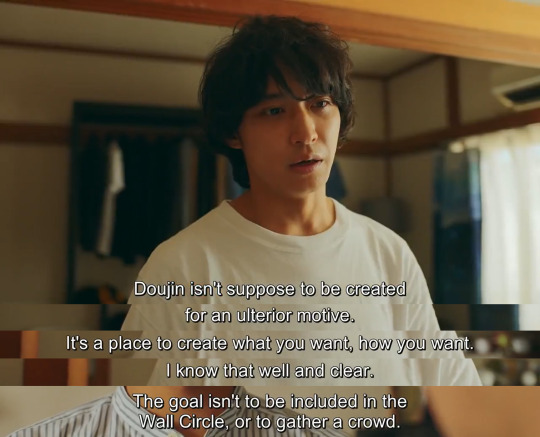
Nekoyashiki draws a second season to his previous work Please Suck on my Enormous, Manly Tits. Despite Yamada’s best hopes, it is not popular at all and loses Nekoyashiki his position as a wall circle doujinshika. He bids goodbye to Suck My Manly Tits series and to ero-manga sub-genre in general.
In a desperate attempt to climb back into popularity, he tries classic BL pairing. We get to see him reading commercial BL as a part of his research. This is an obvious mistake. Yamada wants to intervene but hesitates and ultimately gives up.
When his next doujin, My Perfect Boss Became My Perfect Spouse, also flops, he loses his resolve to be a mangaka.
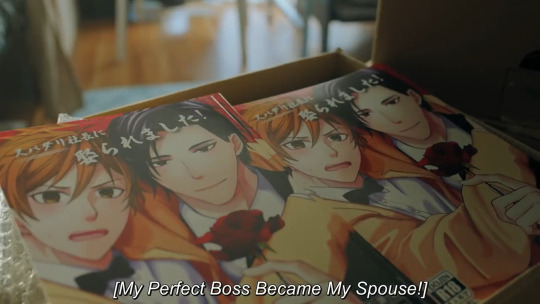
Yamada asks Nekoyashiki to be more honest and expressive in his creation.
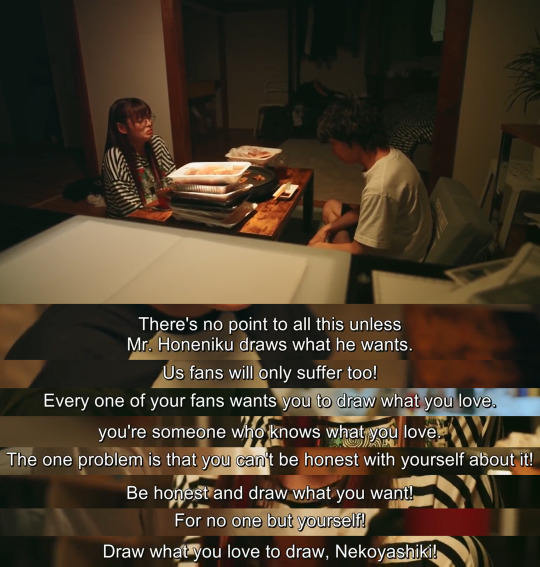
In the end, Nekoyashiki creates a doujin inspired by his own relationship and aspirations – a work that, Framboise and Yamada notices, is to Nekoyashiki’s satisfaction.
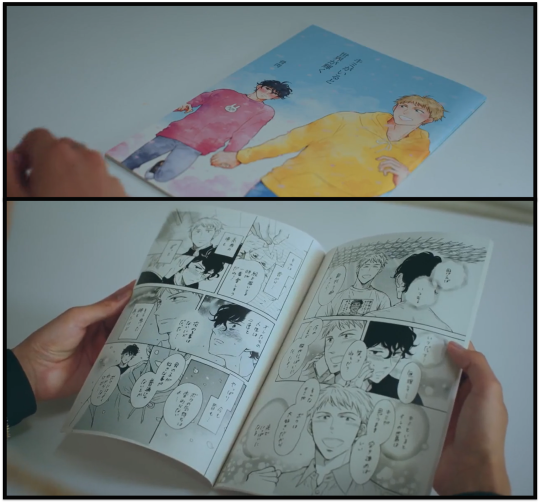
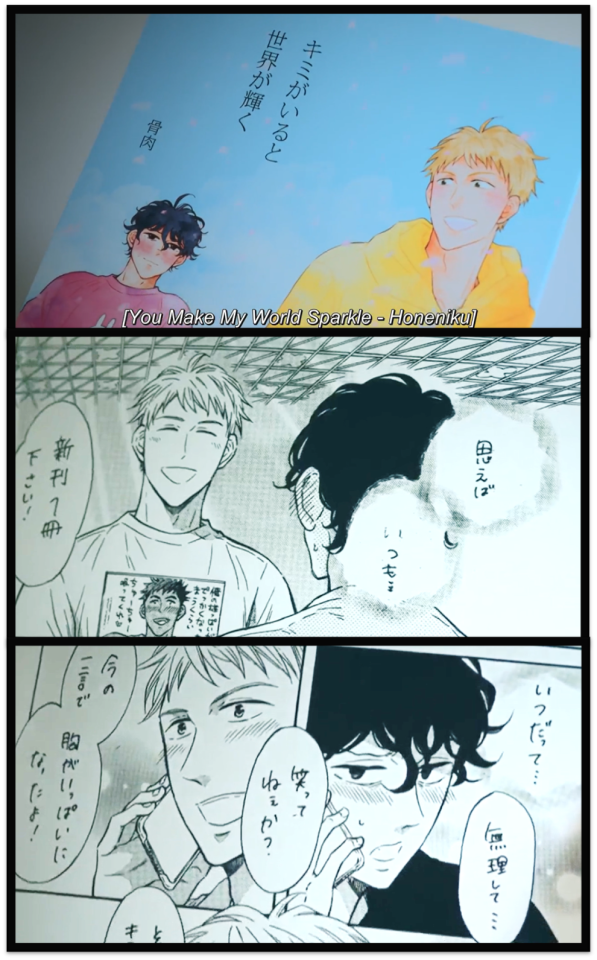
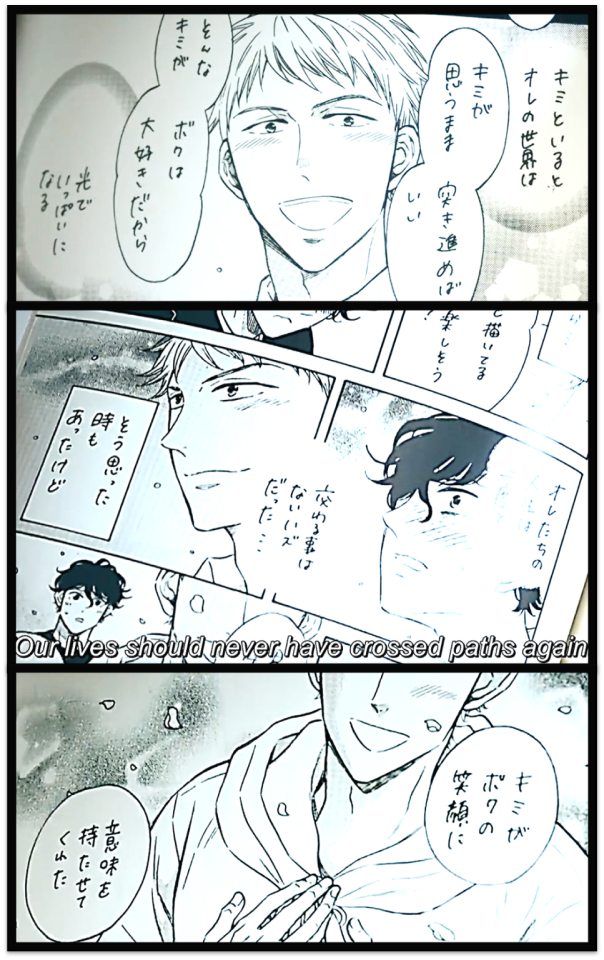

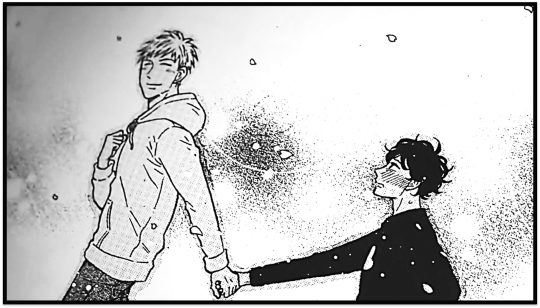
It is common for at least some characters by male BL and gei comi mangakas (who have revealed themselves) to look at least a little bit like themselves. To see examples, check out the beginning of Massive: Gay Erotic Manga and the Men Who Make It where representative art and artists are placed side by side. Some even acknowledge this. e.g. Chinese BL manhuajia Liang Azha once commented on how his shou (uke) tend to look like him as he is today and his gong (seme) resemble his looks from his college days. Moreover, art tend to inspire clothing, haircuts, and other features which in turn inspire art. The influence Tom of Finland had on androphilic men of his days and they on him is discussed in his 2017 biopic. Similarly, mangakas are influenced by their senpais in the field and sometimes it is noticeable in their art too. e.g. Gengoroh Tagame’s historical works looks quite a bit like those of Go Mishima.
Other BL doujinshika in Live-action BL
Yoh from Taikan Yoho (2023) creates his first BL doujin, inspired by his ikemen boyfriend and their relationship, in collaboration with his mangaka friend Manju after his career as commercial mangaka of straight ero-manga takes a nose-dive.
BL Metamorphosis (2022) depicted the process of BL doujin creation in detail as the main character, Sayama Urara, embarks on that journey. Her friends offer her support, especially Ichinoi Yuki who funds the printing and binding. Sayama Urara doesn’t debut as doujinshika as she doesn’t set up her booth at the convention. However, one of the copies lands in the hand of one of her favorite authors Komeda Yu whose commercial BL work Kimi no Koto dake Miteitai was what brought Sayama Urara and Ichinoi Yuki together.
Komeda Yu on the other hand is a doujinshika turned commercial BL mangaka. She visits the convention in hopes of overcoming writer’s block and to rediscover her passion for drawing. She is motivated by the doujin that Sayama Urara created and emerges out of slump to continue with her series.
Fudanshi Bartender no Tashinami (2022) revolves around Soichiro Hibiki, a fudanshi bartender moonlighting as a BL doujinshika, who draws inspiration from his customers and fellow bar staff to fuel his passion.
Minamoto Kazuki
While narrative drives home the point that the various pieces of art we see are works of respective doujinshika characters through haircuts and body types, the fact remains that most of those are actual doujin by Minamoto Kazuki aka MELU. He belongs to the circle: GOOD BYE LIFE.
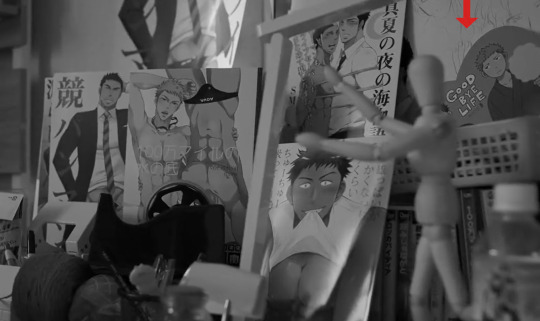
In case anyone want to read them, here are the links:
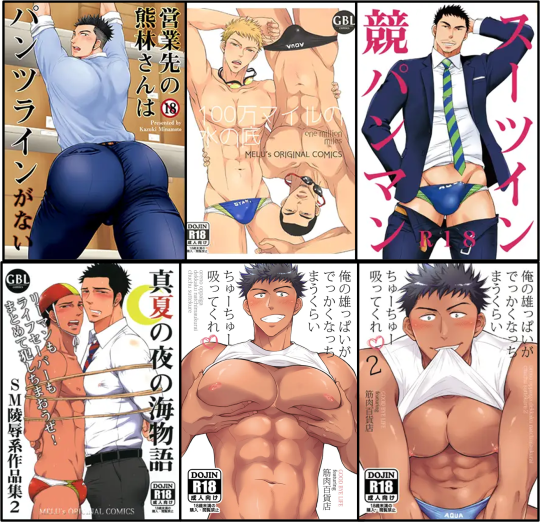
Kumabayashi at Work Has Not Underwear Line
One Million Miles: The Complete Collection
Competition Swimming Brief in Suit Man
A Midsummer Night's Beach Story: SM Assault Works 2
Suck My Manly Tits manga: 俺の雄っぱいがでっかくなっちまうくらいちゅーちゅー吸ってくれ
俺の雄っぱいがでっかくなっちまうくらいちゅーちゅー吸ってくれ2
"Suck My Manly Tits" doujin is in its 3rd season: 俺の雄っぱいがでっかくなっちまうくらいちゅーちゅー吸ってくれ3
Autobiographical pieces that didn't figure prominently:
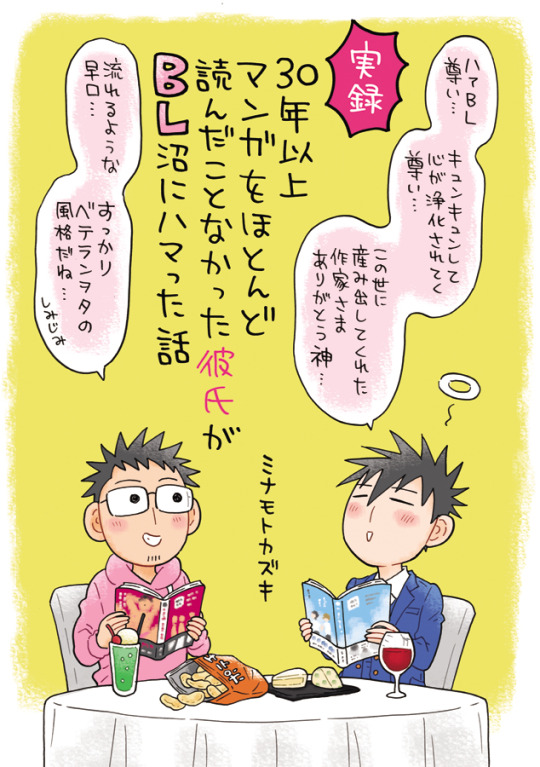
30年以上マンガをほとんど読んだことなかった彼氏がBL沼にハマった話 (A story about how my boyfriend, who has barely read manga for over 30 years, got addicted to BL swamp.)
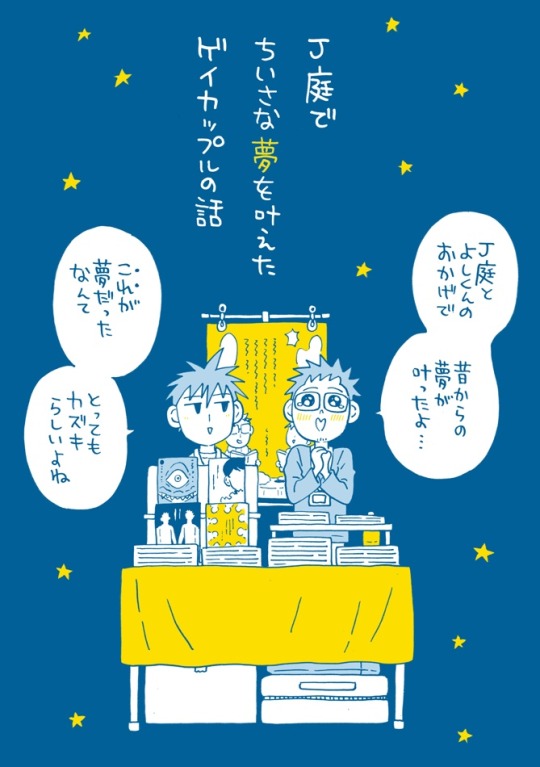
J庭でちいさな夢を叶えたゲイカップルの話 : Story of a gay mangaka and his boyfriend who participated in J.GARDEN, and their little dream that came true.
The cover of this doujin got live-action adaptation in one scene that one would miss if not looking closely:
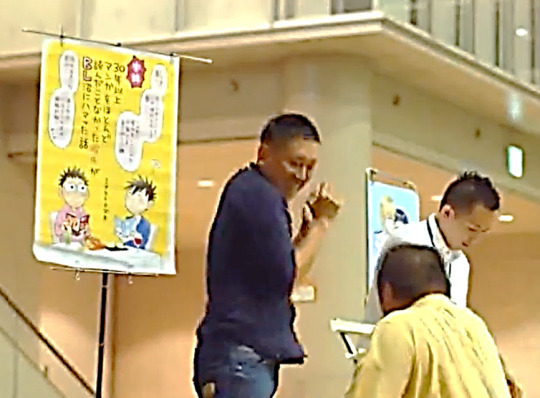
Other interesting works by Minamoto Kazuki
Autobiographical: Shōjo Mangaka no Minamoto-san ga Kaminguauto Shimasu.
2. Those with English translation:
The Midnight Association for The Broken Hearted
The salaryman who has a fetish for suit gets horny.
The Gay Who Turned Kaiju
3. Essay-manga about doujin-making
夜寝て��間にBL原稿のお手伝いをしてくれる妖精さんがいた話
BL同人原稿(アナログ18禁!!)を東京から大阪の印刷所まで届けてくれた彼氏の話
4. About Kabe Koji (2022) live-action:
自分が原作の実写ドラマの大ファンになってしまったので原作者自らヲタ活をしています。
自分が原作の実写BLドラマをリアタイしたくて大阪へ行ってきました。
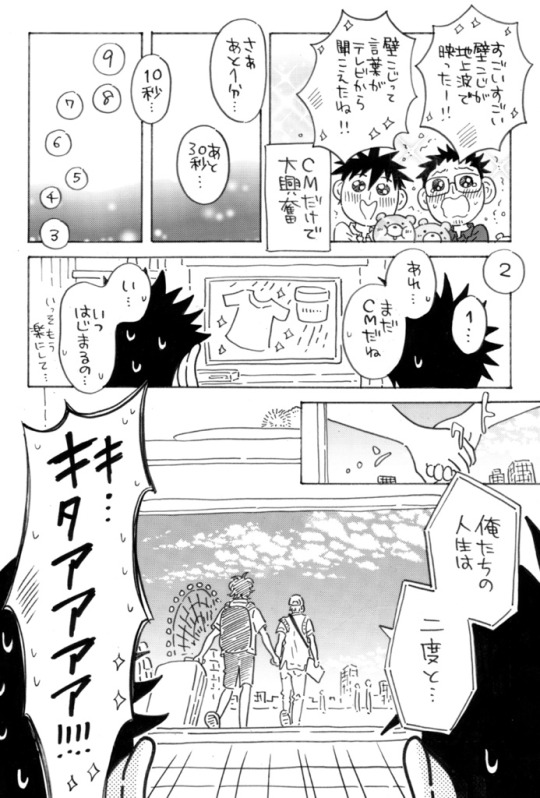
___
This is dedicated to @bengiyo and @liyazaki for gifs featuring Framboise. Thank you very much. While I was trying my hand at a review for One Room Angel (2023) and wanted to express my disappointment at the lean ikemen casting for Kouki’s role, I got an opportunity to use those gifs. I really wish someone would create some gifs for SHIMBASHI TUGBOAT content too.
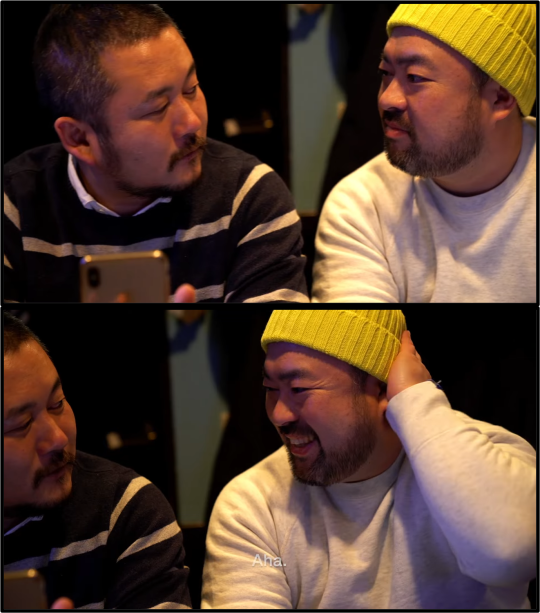
(Especially this scene.)
For someone who is as much a fan of “tribes” as BenZi, I would not mind playing the 9Monster live-action BL bingo version.

107 notes
·
View notes
Text

Source: garuzow (please, visit their Twitter to check other manga artists drawings, like Akira Toriyama and Eiichiro Oda)
Congratulations on your 40th anniversary!!!! ㊗️
New Yoshihiro Togashi drawing displayed at the HOKUTO NO KEN (Fist of the North Star) 40th Anniversary Exhibition that is currently taking place in Tokyo, at the Mori Arts Center Gallery (same place of the Yoshihiro Togashi Exhibition - Puzzle).

The illustration shows Kenshiro, the protagonist of the Fist of the North Star manga series, saying "Congratulationssss" (祝ううううう), and our dear Gon from Hunter x Hunter saying "Hidebu" (ひでぶ).
"Hidebu" is a made-up word by Testuo Hara, according to him:
"Hidebu!" is actually supposed to be a modification of the Japanese phrase "ittai desu" ("it hurts!"), but since the villains are in the process of exploding, the vocal sounds are shifted.
Some weeks ago, Togashi also visited his family's paper shop (冨樫紙店) in his hometown Shinjo, Yamagata Prefecture, and left this signed illustration of Gon, Killua, Kurapika and Leorio.

Source: verses06
The painting is dated September 20th, 2023, and says: "Thank you for the signatures and warm messages!!". Those who visit the paper shop can sign and leave a message in the visitor guestbook.
The paper shop is now run by his younger brother Hideaki Togashi, a very talkative person who was also a mangaka. Unfortunately, their mother passed away a few months ago. Those who had the chance to meet her, says she was a wonderful and kind person.
#yu yu hakusho#fist of north star#HOKUTO NO KEN#puzzle#kenshiro#Gon#hunter x hunter#hidebu#killua#kurapika#leorio#Togashi Paper Shop#冨樫紙店#tetsuo hara#Hideaki Togashi
68 notes
·
View notes
Text
Koei Warriors Retrospective Part 9: Samurai Warriors 2



Samurai Warriors 2 (戦国無双2) Platforms: PlayStation 2, Xbox 360, PC Release dates: Japan: 24 February 2006 (PS2), 17 August 2006 (Xbox 360), 11 July 2008 (PC) USA: 19 September 2006 (PS2), 19 September 2006 (Xbox 360), 27 June 2008 (PC) Europe: 22 September 2006 (PS2), 22 September 2006 (Xbox 360), 27 June 2008 (PC)
For years, what I knew about this game and the Samurai Warriors series in general came from the Warriors Orochi games. I didn't know a lot about the figures or battles of Sengoku era Japan unless I researched it on Wikipedia or eventually played the games.
While writing my personal project in 2014, the order of adapted battles in the story for that year went as follows: Mikatagahara, Odawara, Nagashino, Shizugatake, Okehazama, Komaki-Nagakute, Sekigahara, Ōsaka and Honnōji. If I had a more proper understanding of the game and the era, I probably would have done those things in order, but then again I'm just making up my story and not entirely adapting history.
Like how Dynasty Warriors 5 was made more historical than previous games, Samurai Warriors 2 was the equivalent for its series. This game goes past Nobunaga's era to focus on Hideyoshi's unification of the land and the Battle of Sekigahara, introducing characters associated with said battles. The visuals are made golden to contrast the darker colours of the previous game.
Let's get into the guts of it right after the break.
Samurai Warriors 2
Starting off with the characters now, and one thing to note is that the character lineups are not consistent between games as characters have been cut and reintroduced as the series goes on. As such, Goemon Ishikawa, Kunoichi and Yoshimoto Imagawa have been cut from this game, but their images can still be seen in Sugoroku and the Battle of Okehazama is still mentioned at the start of the Story Mode for related officers.
Okuni and Ranmaru Mori are still in this game, but they have no Story Modes. Okuni is unlocked by winning a game of Sugoroku while Ranmaru is unlocked by playing the first two Mitsuhide and Ranmaru's Requests in Survival Mode. Their fourth (and later fifth) weapons are also unlocked in Survival Mode as well.
Here are the new characters debuting in this game:
Ieyasu Tokugawa (PC'd)
Mitsunari Ishida
Nagamasa Azai (PC'd)
Sakon Shima
Yoshihiro Shimazu
Ginchiyo Tachibana
Kanetsugu Naoe
Nene
Kotarō Fūma
Musashi Miyamoto
Kojirō Sasaki (NPC)
Katsuie Shibata (NPC)
As listed above, Ieyasu Tokugawa and Nagamasa Azai are now made into playable characters, with Nagamasa's seiyuu changing from Takayuki Sasada in 1 to Hiroshi Kamiya from this game onwards. Nene essentially replaces Kunoichi's role as a female shinobi in this game. Yoshihiro and Ginchiyo's introduction also marks the introduction of the clans of Kyūshū, most notably the Shimazu and the Tachibana (through the Ōtomo clan). Katsuie Shibata and Kojirō Sasaki are the new NPCs appearing in this game; they can be unlocked as bodyguards for 6,400 gold in the shop after clearing a mission in Survival Mode. The narrator in the Japanese dub has been changed to Daisuke Gōri, who also voices Shingen Takeda.
Hideyoshi Hashiba is now known as Hideyoshi Toyotomi from this game onwards, with his seiyuu changing from Munehiro Tokita to Hideo Ishikawa. Historically, the name Toyotomi was granted to Hideyoshi and his clan by the Emperor in 1586. In this game, Hideyoshi's surname is never mentioned and he is only known by his former name when he's an ally or enemy before the Conquest of Kyūshū (Shikoku in XL); when you play as him, he will always be known by his new name no matter what battle you play. Later games would make the distinction clearer and more accurate, with Hideyoshi being known under Hashiba or Toyotomi depending on what year the battle took place (except for the stages where he wasn't originally featured in 3 in which case is is always known under Toyotomi).
Story Mode is made up of five (individualised) stages per character (no splitting paths or special conditions) with an extra Gaiden/Dream stage after completing the first five. Ieyasu and Mitsunari, being the leading figures at the Battle of Sekigahara, get a sixth story stage. For Kenshin, Oichi, Magoichi, Mitsunari and Yoshihiro, their Dream stages are unlocked after also fully clearing the Story Modes for Shingen, Nō, Masamune, Kanetsugu and Yukimura. The stages Village Rescue (set in Saika) and Pirate Hunt (set at Ōsaka Bay) are used as filler stages for 10 characters (including Kojirō in XL).
Free Mode is streamlined from how it was in the first game; each (or rather, most) battles have only two sides to play as and they utilise one character's version of each battle from Story Mode (with some exceptions depending on who you play as). Reused stages and Dream stages are excluded in this mode. One thing you will notice is that Odawara Castle has two versions for the west and east sides, though I wish they didn't name both versions as Siege of Odawara Castle (小田原城攻略戦) even though it is technically correct. All battles are one part only (thank god), with castles being incorporated seamlessly onto the maps.
Although battle objectives/missions still exist, battles are not entirely defined by them, meaning that objectives only trigger when you approach certain areas or officers. Also, for the first time, there are no subofficers listed in the officer/Unit Info list, meaning that player characters are listed individually in the list. If you're not a listed officer in the battle, you are shown at the bottom of the list, which is still better than being listed under the commander as "Player 1" or "Player 2". Third-party armies are now displayed in a separate list to the enemy army so more than 12 enemy units can be placed on the map.
Speaking of missions and Odawara, the west map features a mission where you have to defend a siege ramp. The siege ramp in that stage has got to be the weakest siege ramp ever because every enemy that comes near it will try to attack it and it gets destroyed if you leave it alone for more than 30 seconds. The Battle of Chencang in DW5 was less intense in comparison.
Survival Mode continues from the last game. Instead of offering two (or three) modes to choose from, you're given four missions to choose, some of them free and some of them paid. Each mission has five floors and you have the option to save after each one. In the free missions, you have Search for a Hero (強き者求む) which is just randomised missions, or the request storylines from Ranmaru, Mitsuhide and Keiji which cover you for the first 50 floors.
Once you get to that point, you're able to skip up to floor 51 on a new playthrough by paying a fee. The game goes up to floor 100 but you can continue on if you want to. Floor 71 has missions to unlock two rare horses, Persian Mare and Moon Child (Hoshōtsukige/放生月毛). Floor 76 has missions to unlock Katsuie and Kojirō. Also on floor 71 along with 86 and 96 are missions to unlock three Level 4 skills, but you need to have your character's respective Level 3 skills before attempting to unlock them otherwise you're just wasting your time. The good thing is that once you've done this for one character, you don't have to do this again for everyone else. When you get those Level 3 skills, you can just buy the Level 4 skills at the shop.
Sugoroku is a unique mode in that it's a Monopoly-esque game unlike the traditional Japanese board games. You play with four opponents (human or CPU) and the overall objective is to be the first player to achieve a particular gold amount set at the beginning (from 5,000 to 50,000 gold). You can choose between a small map covering only Honshū or a large map covering all of Japan.
As you go around the board, your focus is to obtain three flags scattered randomly on the map and return to home base to move up a rank. While you do this, you buy unoccupied territories to claim rent from the other players and take occupied territories by challenging their owners in one of six different challenges (provided without a separate Challenge Mode).
If you land on a shrine, you'll get to roll two dice to determine what happens to you; you might earn gold, increase land prices (fucking Asian real estate developers lol), take another turn with one or two dice, lose gold, teleport to another square or make things happen to everyone. If you roll a double here, you're taken to achieve a goal in a challenge; completing it will give you 100 gold, but failing it will cause that reward to be rolled over for the next double roll challenge. The weird thing about the shrine dice rolls is that it's hard to determine which die will determine which category or challenge until they land and rearrange themselves (ie, if die 1 lands on the right and it decides the left number, vice versa with die 2). If they made it so you roll one die at a time or made both dice different colours, then you could have a better idea of what to expect.
This game does take some time to play, even for a 5,000 gold target. The bad thing about this is that you can't save and move onto something different, even in a single player game, but that's what emulators are thankfully good for. At the end of the game, you get about 12.5% of your final gold total to use in the rest of the game, which is just paltry for the effort required to play it. I'll come back to gold earnings later.
In battle, Special Skills are a new mechanic introduced in this game, triggered by pressing R1, then pressing either Square or Triangle. This functionality replaces ranged attacks from the first game. With the introduction of Special Skills, a very small number of characters are able to summon horses, those characters being Yukimura and Keiji (and later Toshiie in XL). If you ask me, it is a bit unfair that only three characters can summon their horses, but rest assured that this does get fixed in future titles.
Two new moveset types have also been introduced for characters in addition to the Charge Attack moveset from the last game, namely the Normal Attack moveset and Special Skill movesets. Some characters from the last game retain their Charge Attack moveset while others have their attacks reassigned for the Normal Attack moveset or nerfed for the Special Skill moveset. For the Normal Attack moveset, Normal Attacks go up to N12 while Charge Attacks go up to C8 and are single-tiered. For the Special Skill moveset, it remains similar to the Charge Attack moveset except the Charge Attacks are only double-tiered, but both Special Skills are triple-tiered.
The Musou bar is upgradable to three levels, with the maximum reached by the time you reach the maximum level of 50. You can unleash a Musou Attack as long as the first section of the bar is filled, meaning that you can only manually charge it up to that point (but let's face it, who does that anyway). The first and second level Musous only affect the colour of the finishing shockwave (from blue to green) while the third level Musou adds a secondary effect depending on the character (while also changing the finishing shockwave to yellow). The same applies to the True Musou Attack as well.
Holding down the Circle button on horseback no longer swings your weapon like it did in the last game and DW, but you can still perform Normal and Charge Attacks while charging around. This game would begin a trend of horseback Musous just being bland rampages.
The right analog stick can now be used to rotate the camera, something that would be included in future Warriors games from this point forward.
Between battles, you will be able to access the shop to upgrade your weapons and skills. The shop is run by Saya, the master's daughter from the first game's New Officer Mode (who also slaps Magoichi in the first movie of his Story Mode). She will continue to make appearances as the shopkeeper in future games.
Four levels of weapons continue to be offered from the previous game. Weapons can have up to eight slots for attributes (going up to level 20 in a similar manner to DW5) and they can also have an element that is activated when you have one level filled in the Musou Gauge. The Dark element from the last game has been replaced with the Wind and Demon/Death elements. You can upgrade your weapon with a random ability for the price of 100n + 400, where n is the number of times you've upgraded your weapon. There is a chance that you may get a duplicate attribute; the stats do stack but you can have a maximum of 3 copies for that particular attribute.
Skills are a new mechanic that replaces the item system from the first game. Characters can learn skills by buying them in the shop, levelling up or stealing (or rather, learning in the English version) from enemy officers. Excluding rare skills, you'd be looking at spending 81,600 gold to buy all non-rare skills up to level 3, then another 30,000 gold to get the three level 4 skills. Rare skills can be learnt on Hard difficulty and above by defeating certain playable officers. When your character reaches a certain level (in a multiple of 10), they will learn a quasi-unique Self Skill. Skills can be turned on and off before starting a battle.
Bodyguards are also reduced to being a single officer instead of a group of four soldiers (also similar to DW5). They can be levelled up to a maximum level of 20. There are 10 classes of bodyguards and you can keep up to 8 of them (out of a total of 54), but if you were to hire everyone, you'd be looking at spending 153,900 gold. Once again, bodyguards only have voice lines when they are killed.
My main gripe about this game are the costs to purchase things in the shop when compared to the amount of money earned each battle. Amongst the collectible items in the game, you can collect up to 100 gold at a time, with level 4 Greed giving you a multiplier of 1.8 for a total of 180 gold. Given how much things in the shop cost, you can only really afford to do so much before you run out of money. Compound that with the fact that there are 26 playable characters in this game (32 with Xtreme Legends) and it does take a while for you to get your character decently powered-up. Of course, if you've spent a lot of time on this game (particularly 18 years ago when this game was first released) then this will be nothing to you, but this is coming from me who's only been playing it for two years in the hope of eventually reviewing it.
New Officer Mode has been removed in this game, but the closest thing to playing the CAW sword, spear and naginata movesets, along with the movesets of various troop types, is by using one of Nene's Special Skills, which can make her disguise herself as a nearby soldier or officer.
No new voice lines have been recorded for Survival Mode (like with the last game), so the only voices you'll be hearing are those that were already in the rest of the game. Some lines have been recorded for player characters in Sugoroku, but I'm not sure if they were also heard in other areas of the game. This can't be traced back to lazy localisation (we haven't even got to that point yet) because I've been playing this in Japanese and I've experienced the same thing, though I suppose if the lines were voiced in the Japanese version and not the English then this issue wouldn't have stood out that much and I probably wouldn't have noticed it when I did.
Now let's talk about the English localisation of this game and hmm... are those the English voice actors being credited in the credits? Breaking with what should be tradition for Warriors games, the localisation for this game was done in Canada, the actors provided by Total Casting and the dubbing produced by Agile Sound, both being subsidiaries of Montreal-based Agile Entertainment. No justification is given as to why Koei decided to use another company instead of Voicegroup for localisation, but a lot of fans I've seen do seem to like the English dub for this game. As someone who came to this series after playing Warriors Orochi however, I honestly can't get used to it as it sounds kind of bland in some places, but hey, I guess that's my toxic nostalgia talking. Looking forward though, I can see how some character lines from this game inspired those in Warriors Orochi.
For the first time, the PC port of SW2 does not have any enhancements like DW4 Hyper or DW5 Special. Once again, given the timing of that release, the lack of Xtreme Legends features in PC ports continues to confound and infuriate.
Samurai Warriors 2 Xtreme Legends
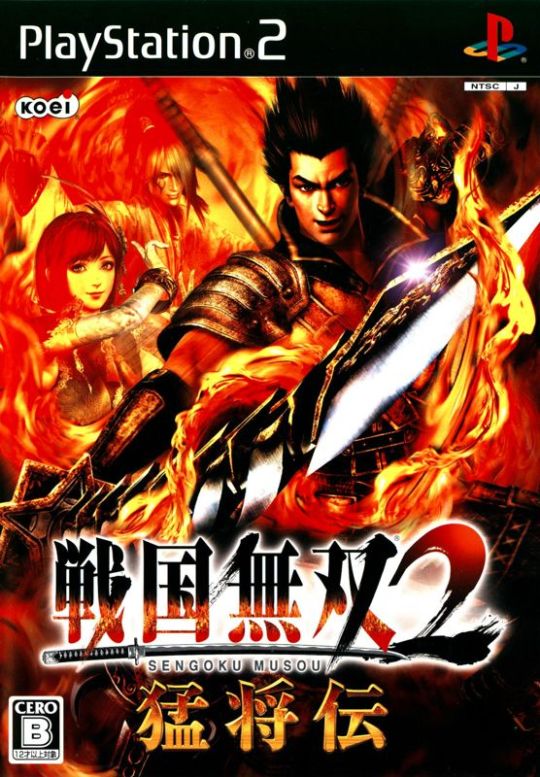
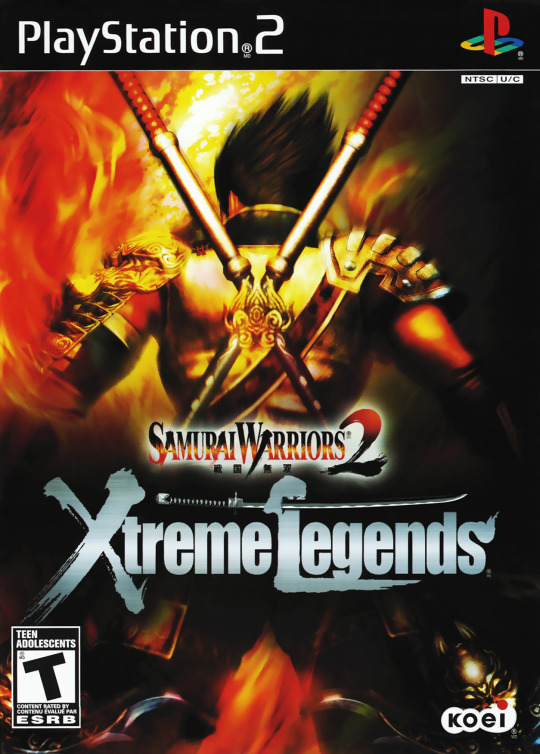
Samurai Warriors 2 Xtreme Legends (戦国無双2 猛将伝) Platforms: PlayStation 2, Xbox 360 Release dates: Japan: 23 August 2007 (PS2), 14 April 2008 (Xbox 360) USA: 18 March 2008 (PS2), 16 April 2008 (Xbox 360) Europe: 28 March 2008 (PS2), 16 April 2008 (Xbox 360)
Uniquely, the Xtreme Legends expansion for SW2 was released after its Empires spinoff, explaining the nearly 18-month gap between the vanilla game and the expansion as opposed to the 6 month gap in the case of DW4 and 5. At least DW3XL came out nearly a year after its vanilla release.
This game also marks the first time that (the full content of) an Xtreme Legends expansion is made available on a non-Sony console. With the Xbox Live Marketplace being the first digital game distribution shopfront of its kind, SW2XL was made available on the Xbox 360 as DLC in April 2008, it being compatible with both the physical and digital versions of the vanilla game. Such a shame it's no longer available for purchase now that the marketplace closed down at the end of July 2024.
In Japan, the DLC release was a month after a physical version was sold on 19 March 2008 in the form of a "with Xtreme Legends" Complete Edition. This also begins a confusing tradition of Complete Edition games being released alongside Xtreme Legends expansions exclusively in Japan. Such a thing wouldn't happen in the West until DW8.
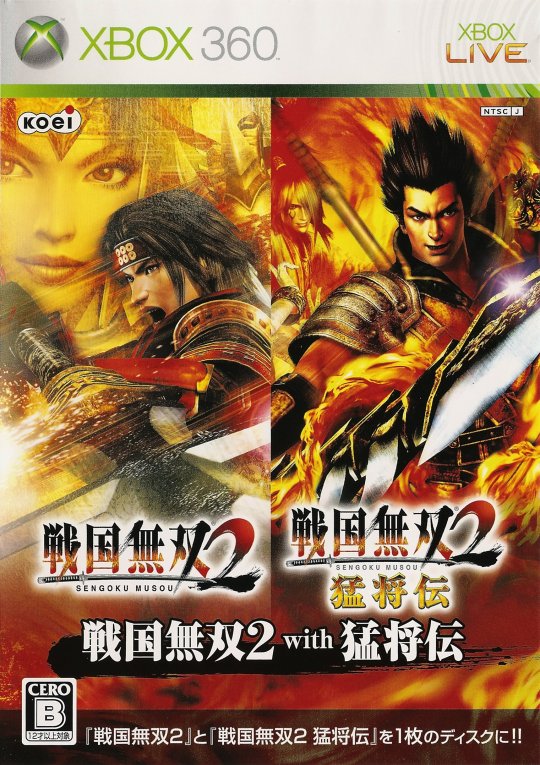
Some PS2 players have reported issues with this game, particularly those with older "fat" models and Slim models, due to the game being on a dual layer DVD-9 disc and the laser reader sometimes having issues with it.
5 new playable characters make their debut in this game:
Toshiie Maeda
Motochika Chōsokabe
Gracia
Kojirō Sasaki
Katsuie Shibata
Kojirō and Katsuie were previously made playable in Empires, but this game gives them new unique weapons. Motochika's introduction introduces the Chōsokabe clan of the Shikoku region as well. Gracia, the daughter of Mitsuhide Akechi also known as Tama(ko), is never named by any of the characters in any game she appears in. Granted, Gracia is her Catholic name and she wasn't baptised until 1587 when Hideyoshi was conquering Kyūshū, but it's kind of weird to have characters refer to her as "Mitsuhide's daughter" or something vague.
Yoshimoto Imagawa makes a return in the expansion after being cut from the vanilla game. As such, Okehazama returns as a stage in this game and a new stage, Shikoku, is introduced.
Toshiie Maeda is an example of a generic officer being upgraded to a playable character in the expansion. However, the extent of how he is upgraded when seems to vary. See, the assumption is that when a generic officer is made playable in an expansion, that officer's appearance in other stages is upgraded to their playable appearance (which does happen in later games). In the case of Toshiie in this game, some of his appearances are straight-up upgrades, but in some stages he is replaced by another generic Oda officer like Nagahide Niwa, Nagayoshi Mori or Nagachika Kanamori. This happens regardless of whether Toshiie was an allied or enemy officer in the vanilla game.
So yeah, all the Xtreme Legends trimmings are there, from Story Modes for the new characters, Novice and Expert difficulties to fifth weapons for all characters, including Ranmaru and Okuni which once again, are only unlockable in Survival Mode. Levels are increased to 70 for player characters and 30 for bodyguards.
In regards to Musou Mode, the final cutscene movie of Toshiie's Musou Mode has been changed in Western releases for the Xbox 360 and the European release for the PS2, but it is intact in the US release for the PS2 and all Japanese releases. The original cutscene shows Toshiie, in grief over Katsuie's death, punching out Hideyoshi while proclaiming his new duty to watch over him and share the burden he bears. In the changed versions, the cutscene was changed to be a shortened replay of Katsuie's final cutscene where he farewells Toshiie before resigning himself to his fate inside a burning Kitanoshō Castle. I presume this decision was made for censorship reasons due to violence, which is kind of weird considering the nature of this game and the fact that Toshiie gets punched himself in earlier cutscene movies.
New charge attacks are introduced for all characters, namely the C5 for the Charge Attack and Special Skill movesets and the C9 for Normal Attack movesets. They are all single tier and some of those attacks may also incorporate elements of their Special Skills.
Two new sections have been added to the shop. When your character reaches level 19, Special Skills will be available for purchase, but note that buying one only buys it for that character and not everyone else. To buy all 15 Special Skills you'd be looking at spending 417,000 gold per character. If you don't want to spend that much, then take note that some characters' Self Skills are the same as Special Skills such as Finesse/Spring, Resist/Balance, Omniscience/Awareness, Pressure/Repel and Resist/Confidence. Only one Special or Self Skill can be equipped on a character.
The other new section in the shop is Orb Synthesis. Using orbs, you can directly add attributes of +20 to your weapon or even change your weapon's element, even for fourth and fifth weapons and weapons with no attribute slots. Orbs are mostly obtained through Mercenary Mode, but in rare cases they can also be found in Story and Free Modes (though I suppose the chances are higher on harder difficulties). The cost to do this is x*y where 0 < x < 9 for the number of slots and y < 5 for the weapon level, which potentially makes it more expensive than when you upgrade a weapon normally. Weapons without attribute slots (usually initial weapons) are treated as if they had one and fifth weapons are charged the same as fourth weapons. The maximum limit of three copies per attribute still applies.
Mercenary Mode is the new unique mode added to this game. It serves as a great grinding mode for experience, gold and orbs, plus this is arguably easier than Xtreme Mode in DW4XL and 5XL, probably because it carries over your gold and character stats from the rest of the game.
After selecting your character, you can choose from three battles that all have different objectives and handicaps, such as starting with low health, multiplied damage or nullified guarding. You earn gems after each battle and as rewards for completing special missions.
Guards can also be hired between battles for 10 gems each. You can deploy two guards at a time with an additional three in reserve. After playing or deploying a character for a certain amount of turns (certain rewards can reduce this), they are able to be levelled up, granting them an additional skill. Skills include automatically opening gates when approaching them, using some of your Musou gauge to create a barrier, earning an extra gem every 50 KOs and nullifying enemy quagmires (giggity)/birdlimes/tar traps, poison attacks and fire attacks. Skills apply from both the player character and the guards deployed, so it's a good idea to ensure you have as many bases covered as you can.
As you play battles with clans, they will give you rewards the more you play with them. When you play 7 battles under the same clan, you will be offered to join them as a retainer for 50 gems. Once you do, no other clan will give you rewards while the clan you joined will continue giving you rewards the more battles you play under them.
Special events will appear in the menu throughout your playthrough. Some of these may be rewards from various people, requests for assistance that unlock special missions, or offerings that unlock Precious Swords. I'm not sure if those missions expire, but if you're aiming for the second ending, then it's a good idea to complete them as soon as you have the gems for them.
There are two ways to clear Mercenary Mode. The first way is to join a clan and fight another 7 battles under them for a total of 14, at which point you can fight a battle to unite the land and clear the mode. The second way is to collect all ten Precious Swords and unlock a battle for supremacy, where you will have to fight three officers in hyper mode to clear the battle. This battle doesn't happen until you reach battle 100 because of how the Precious Swords are collected and there's nothing special after that. As such, there is no reason to replay with the second way other than to get the associated achievements/trophies because the first way is faster.
Like with Survival Mode in the vanilla game, no new voice lines have been recorded for Mercenary Mode. Is it so much to ask for consistency?
Samurai Warriors 2 Xtreme Legends HD Edition (Sengoku Musou 2 with Moushouden HD Ver.)
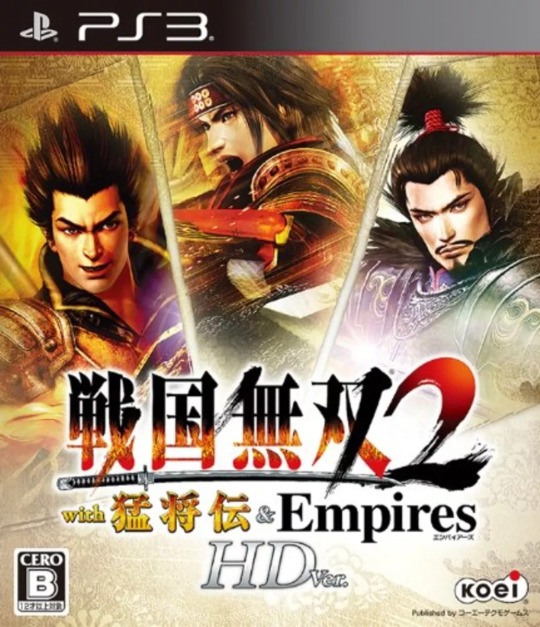
Samurai Warriors 2 Xtreme Legends HD Edition (戦国無双2 with 猛将伝 HD Ver.) Platforms: PlayStation 3, PlayStation Vita Release dates: Japan: 24 October 2013
This is the version of the game I've been playing for the purposes of this review. Why did I pick this version for it? Well, I was able to get most of the Samurai Warriors games on the PS3 anyway, so why not get this version of SW2 and make RPCS3 my Samurai Warriors hub? Sure, I could play the Xbox 360 version for a widescreen experience that's closer to the original PS2 release, but why the hell should I go to the effort of setting up Xenia for it when I could just get this?
In 2013, Koei (Tecmo) rereleased SW2XL alongside Empires in an HD Edition for the PS3 and PS Vita. Both games are sold separately on the PlayStation Store, but on the PS3, they can be bundled into a single digital package or a physical disc, meaning that when you launch the game, you are greeted with a launcher that allows you to select between the two games. This also allows you to switch between the games by going back out of the main menu and into the launcher without having to change discs or exit to the Home Screen/XMB. Save data and trophies remain separate between the two games.
The main enhancement of the HD version is that this version takes advantage of the PS3's capabilities to deliver improved graphics and more enemies on screen. Apparently this version also makes use of the AI engine from the next game, Samurai Warriors 3, and while I haven't seen any Japanese sources to confirm this, I can say that you do get a bit of that feeling, particularly in Empires. All modes and characters are available from the start.
With this game also being available on the Vita, ad-hoc multiplayer gameplay is available (Sugoroku only allows you to have two players playing wirelessly against two CPU players). Cross-save functionality is also available between the PS3 and Vita through the PlayStation Network. This would also become a thing for later games, although in general, I wish Sony made it so that save files can easily be copied between different consoles, like the PS3 and Vita via USB, without necessarily having to be logged into the PSN. However, this would essentially require companies like Sony to believe in the philosophy of free and open source software (FOSS).
If there's one thing I could say about this port, it would be, WHY WASN'T THIS PORT RELEASED TO THE WEST? The localisation already exists, so it would be easy to publish a localised port of a remastered game. Considering what happened with the Western release of Samurai Warriors 3, this game could have been an easy cash grab to make up for it while also being a nostalgia trip for people who played the game on the PS2 or Xbox 360. Koei (Tecmo) aren't the only main factor in this as Sony also plays a factor in the decision to publish games and ports. This is something I'll come back to when we cover Warriors Orochi Z.
Rant: Why I play in Japanese/MobileJOY
Before I started this retrospective, I stated that I would be playing the Japanese or Asian versions of the games over the English versions where possible. There are multiple reasons for this.
Firstly, there are some games and ports that were only available in Japan/Asia, such as SW2XLHD, SW3Z and WOZ. Secondly, and this ties into the first reason, I don't want to waste time setting up and going between other emulators (like Dolphin for SW3 on the Wii or Cemu for WO3 Hyper on the Wii U) to play the games in English. As it is, I'm already playing Xtreme Legends expansions on one console per game to save time and effort.
Thirdly, and this reason is more for the later games, I play Japanese/Asian versions because I'm disappointed with Koei Tecmo's treatment of localisations, not just with the lack of English dubbing, but their translation decisions and errors. "But Azuma, translation errors existed in earlier games as well!" Yes, I know and I have noticed them despite their rarity, but I'm bringing this to the forefront because of Koei Tecmo's complacency to these incomplete localisations and apathy to their Western fanbase in regards to this. I'll talk more about this when we get to Warriors Orochi 3.
The main exception to this rule mostly involve games that I already have on portable consoles, like the first few Warriors PSP games. Playing older games in Japanese is mostly for consistency with later games. In the case of the PC games, it's a mixed bag. I already had DW8XL and DW8E in English and I recently downloaded the Chinese versions for them, DW6 and WOZ are in Chinese and the other games have language options which I might utilise, but for the most part I play in Japanese or Chinese.
Now in regards to playing with the Japanese version, you might notice a section in Camp or Options called MobileJOY (like how the "import" function is also known as MIXJOY). Basically what it involves is that you go onto Koei's Musou Mobile website (with your phone) and enter the code on the screen, then it will give you a password that you put onto the screen to unlock the bonuses, which typically involve in-game items. Some games also have additional tie-ins to GREE's 100-man-nin collaboration series, such as with Samurai Warriors 3 Empires where you can unlock characters and rare items in its 100-man-nin counterpart, and in turn, you can unlock special buildings from that game in this one.
The Musou Mobile service, and with it MobileJOY, was discontinued in March 2020. Presuming that the password is generated by the game every time it is booted or you go into the MobileJOY page, that means that the game would also have the password to unlock the bonuses, so technically all that is needed would be the formula to cracking the code. But it doesn't seem to unlock anything special so maybe that's why people don't seem to want to bother with it.
In spite of Koei's decision to use a Canadian company to localise this game (and one from Quebec no less), Samurai Warriors 2 was the certified hood classic that defined the childhoods of its fans just as Dynasty Warriors 5 defined those of others including myself. It apparently had such an impact that it got Koei to get off their asses and release its Xtreme Legends expansion on the Xbox 360 before later remastering an already HD-capable release to the PS3 and PS Vita seven years after its original release. If SW1 is comparable to DW3 and DW4, then SW2 is comparable to DW5, something that would be cemented in a later crossover spinoff series.
Empires is up next for review followed by Katana, those being the spinoffs for SW2.
#samurai warriors#samurai warriors 2#samurai warriors 2 xtreme legends#koei tecmo#koei warriors#koei warriors retrospective
5 notes
·
View notes
Note
cioo :(( do your fankids prefer a parent over the other? (looking at fukumori fanchildren)
ok so specifically for the fukumorilings within bspverse:
junichi: no, he will go to different parents for different things (mori is better at talking through problems and offering physical comfort, fukuzawa is better when quiet comfort and straightforward advice is needed, for example) but at the end of the day he doesn't prefer one parent over the other
makoto: mori. she's always been a papa's girl
hyakken: technically no? he spends more time with mori by virtue of being in the port mafia but he doesn't like. prefer him or anything. as a baby he would randomly switch up his preferences (aka he would scream and cry if one parent wasn't holding him but the other was, but which parent he wanted holding him would change by the hour at times) but that only lasted until he was about a year old
tsutomu: fukuzawa. even in the depths of his "i hate my dad bc i think he doesn't love me" era, he wants to go to fukuzawa for things, but the mental illness(tm) keeps him from doing so, which leads to him suffering in silence a lot. it sucks!
tatsuji: fukuzawa. she's less close to him than tsutomu is/was/is eventually again, but he's her favorite
yuriko: mori by a landslide. much like makoto, she's papa's little girl, but unlike makoto, her emotional instability meant that her crying fits and emotional outbursts when she was little led to her seeking out mori more often than makoto did (makoto rarely cried as a child and if she did it was for something world-ending, yuriko would scream wail if her ice cream tasted off)
tsuneko: mori. she's also the only child who will let mori play dress-up with her (aka choose her outfits & buy her clothes) whenever he wants because she likes having a wardrobe the size of which would make fitzgerald clutch his pearls and gasp at
kazukou: fukuzawa. this isn't surprising considering how alike they are
yoshihiro: no parental preference, but they most often turn to riki (their service dog) in times of need because riki is most often literally right beside them, and they've been together since yoshi was 5 and riki was a puppy. they're besties
you can find these kids' profiles all here btw
send me asks about my aus
#bsd#bungo stray dogs#bungou stray dogs#fukumori#zskk#zenki soukoku#bsd oc#bsd fankid#bsd ocs#bsd fankids#my kids#my fankids#bsp#bspverse#bsp lore
9 notes
·
View notes
Text


Mariko Mori at home, shot by Yoshihiro Makino.
31 notes
·
View notes
Text
untitled project devlog 8: themes, and pain
At first, when I said I wanted to discuss the themes of my project, I thought that maybe there would be some convenient article, book or philosophy deep dive I could reference, which does not seem to be much the case, seeing as how my approach to themes is very personal. so… here’s some thoughts.
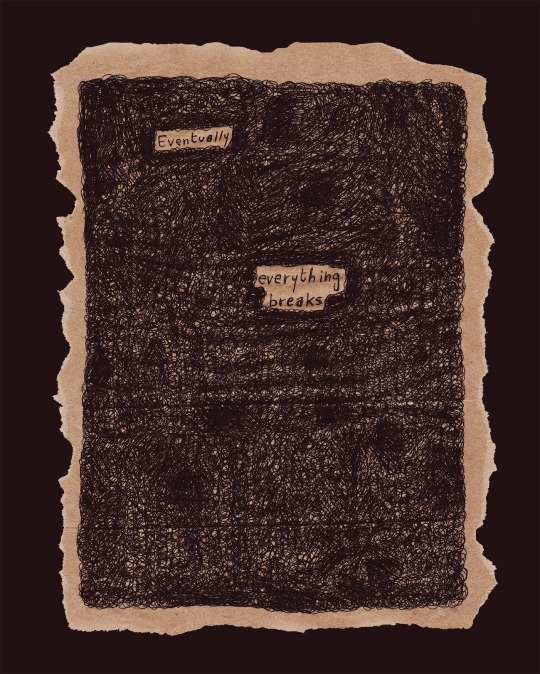
In case it’s not abundantly obvious by now, the story features a band and music quite prominently. One of my original elevator pitches for the comic was “think metalocalypse meets bandslam, but with the scope of Ernest et Celestine and the presentation of a black and white Wes Anderson film” which is the vaguest shit ever and I’ll eventually get my head out of my ass long enough to stop worrying about spoiling the story. My point is: the act of being creative is at the forefront of the story. What drives it forward is something I won’t mention in this series, but a lot of ideas emerge when you decide to write something as personal as making art. Things like purpose, belonging, self worth, expression, communication, validation are things that every artist or musician deals with quite regularly and no story about creativity would be complete without them.
The first post ever made to this blog was a webcomic name fancomic that, looking back, isn’t bad but remembering the reason why I made it is what makes me cringe. I wanted attention. When I started making art I expected to be famous in 100 days. literally, I wish I was exaggerating.

In every artist’s journey with art, they reach the point where they realize that the only things really worth pursuing are the things they’re passionate about. Sometimes this is drawing commissions, other times people do commissions to keep themselves alive. A lot of times, the art people are passionate about barely gets any attention at all. It's a fact that a lot of creatives secretly know that people who get successful doing something they love are very lucky.
youtube
It takes maturity to be happy for people and proud of their hard work as opposed to being an envious child but that doesn’t mean we don’t secretly want success as well. If I could have enough dedicated readers to make my comics for a living but never be famous I’d do that in a heartbeat. Every big shiny thing is destined to accumulate dust, I don’t want to be a big shiny thing, I want to be a reliable hill you can trust to be there year after year. It took me a while to get to the mindset I work with today. 6 years might not feel like a lot when you consider the insane careers some artists had, but as far as people go 6 years is a lot. I graduated, finished a book, worked on 2 short film productions that have both won awards (one of which for my sound design!!), moved house, freelanced, started a stable job, been to therapy, gotten an operation, nearly lost people, been through an explosion, an economic collapse; and I think that’s just the stuff I’m remembering off the top of my head.
Finding documentation and sources about this kind of stuff is pretty difficult because this is not what gets publicized about media. However, if you pay enough attention some similarities start to appear.
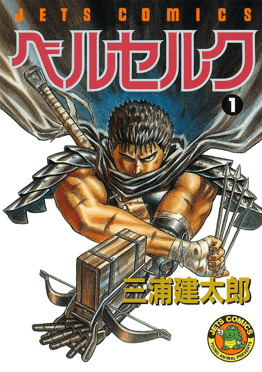
The manga Berserk is pretty famous for its elaborate artwork and story. It doesn’t really need an intro and I’ve been told I need to read it which I plan on, but that’s not the point right now. As you may know, Kentaro Miura, the author and illustrator of the manga passed away in 2021. For fans of the series, while very tragic, this wasn’t all that surprising. The dude doesn’t fill in black. he crosshatches everything. An admirable feat, which makes you thankful that a friend of his, Kouji Mori, decided to finish making the manga after he passed away.
Many other manga share this. Vagabond by Takehiko Inoue, has been known to frequently go on hiatus. So has Hunter x Hunter by Yoshihiro Togashi. A lot of times, an artist’s undying faith to their work is because of how passionate they are about it, the people involved in making it or even the audience. I forget the exact interview this is from, but Linkin park has gone on record for saying that sometimes they need to consider the audience. you see them always excited to talk about how experimental their music is, which is great, but when you know someone’s on the receiving end of what you’re making, it’s bound to make you think a bit differently.
This video of George RR Martin and Stephen King chatting kind of outlines the different approaches they have to writing. One of the most iconic quotes is “how do you write so fast?” Spoken by Martin. Now I’m not here to talk about Game of Thrones, trust me I couldn't care less but it does bring up one point worth talking about which is inspiration, discipline and what that has to do about your malleability as an artist.
youtube
This is the trailer for H.E.R.A., one of the short movies I worked on as a sound designer and general handyman. It was written and animated by my friend Alaa Fleifel with the help of some wonderful fellow artists and animators for some of the scenes. Alaa and his studio Phat Chik are an example of what I’m talking about.

pictured: Alaa.
When I talk about being malleable, I don’t mean that in the X-men mystique “I chameleon my way around the world” school of art though that can work in some cases, sure. What I refer to is one’s ability to keep making their art. During the production of H.E.R.A., there were at many points obstacles that would have shot down most movie productions. The sound designer had to prioritize staying alive so he had to unfortunately quit the project midway. Alaa had to juggle a fulltime job, commissions and a rapidly decaying economic system that meant most clients didn’t want to pay well anymore so he had to outsource some of the background art and scenes to friends and animators that he paid out of pocket. The production timeline lasted a year and 8 months, most of that time was spent patching up the team in the background. Working on H.E.R.A. taught me that there is no project in existence that is the result of one human being. Everyone has at least one person to give them advice, someone who goes “hey, I know a guy” and very often that is not just one person. When band line ups change, it’s sometimes treated with an air of disregard.
“oh, it’s just the drummer”
“it’s the rhythm guitarist, their job is pretty easy anyway”
Had Alaa waited around for inspiration or permission to make his film, it would have never happened. Sure, a lot of why we get to watch the absurdist sci-fi acid trip that is H.E.R.A. is due to some luck and connections, but a lot of it is also due to a rejection of the notion that inspiration is what primarily fuels creativity.
So what does that say about the story? usually I find it helpful to present my themes in the form of questions, so here’s what i’ve been able to come up with:
Who does art/music belong to?
How much of the soul of art and music gets lost in translation?
How do you balance making stuff for yourself and an audience once you have one?
How much does inspiration really matter?
I need to be honest with you about something.
I’ve been kind of avoiding talking about the more… personal themes at play here.
it’s not because I don’t know what they are, really. They just come from a place of deep discomfort and humiliation for me. I’ve obviously become a much different human being over the course of my 27 years on the rapidly traveling rock in space but it’s never not weird for me remembering the dumb things I did or said growing up or while I was finding my footing as a writer. There are entire projects and dozens of pages of things that I threw out the window before I felt confident enough in something to be able to share it. there’s a lot of fucking up you do while growing up and not surprisingly, I feel more comfortable seeing my weird feelings in fiction than I do laid out in bullet points in a devlog. So I promise you this:
the people in the story are going to be human. Faults, warts and all. The only thing I ask of you is to know that while those warts are real, they are not mine anymore. Every day that passes, I grow a little bit more, and maybe at some point I’ll grow tall enough that the light trickling through the trees will feel safe enough to fly.
Merry Christmas, and may every year bring a little bit more sun.
Devlog updates on tuesdays.
4 notes
·
View notes
Text












Mori Art Museum, Tokyo First solo exhibition in Japan by Internationally acclaimed artist Theaster Gates (b. 1973). Practice encompasses ceramics, painting, sculpture, music, and performance, as well as land art projects that transform neglected buildings into centres of creative innovation and demonstration with his own unique aesthetic.
Image 2: Theaster Gates A Heavenly Chord This installation is a sculptural intervention with seven Leslie speakers and a Hammond B-3 Organ - a staple in Black churches, and Gospel music throughout the US - represent as a symbol of spiritual transference through monastic music and experimental sound
Image 4: Theaster Gates Yellow Tapestry with Black Stitch (2024) In this minimalist work, Gates creates tapestries from decommissioned fire hoses to reference how state forces usd high-pressure fire hoses to violently disperse peaceful protestors during the civil rights movement in the 1960s. Gates' celebrated "Civil Tapestry" series demonstrates his investment in colour field paintings and conceptual formalism.
Images 8 & 9: The Koide Yoshihiro Collection 1941-2022, Stoneware This collection of ceramic wares documents the practice of Tokoname potter Koide Yoshihro (1941-2022). As a study on the Tokoname style of ceramic production, nearly twenty thousand ceramic works here represent the life and labour of a potter. Presented en masse her in the gallery, Gates artfully demonstrates the process of caring for, packaging, cataloguing and stowing a large collection of sensitive objects.
Image 11: Hung Su-Chen The Kiss (1996) 2-channel video (colour, silent), CRT monitor, red string
Image 12: Louise Bourgois Maman Bronze, Stainless Steel, marble
0 notes
Text
The Traces of 1998-2006 DISC6 [ Toshiki Kadomatsu ]
The Traces of 1998-2006 DISC6 [ Toshiki Kadomatsu ] http://wp.me/p2DcL8-iU
Toshiki Kadomatsu 25th.Anniversary “The Traces of 1998-2006��� Disc6 of 8set released on 2007/08/25 Toshiki Kadomatsu (Vocal / Guitar / Lyrics&Music) Tripod are; Toshiyuki Mori (Key / Rohdes ) Shingo Kobayashi (Piano) Yoshihiro Tomonari (Piano) Kadomatsu Band are; Tsuyoshi Kon (Guitar) Hideki Matsubara (Bass) Michiraki Tanaka (Per) Gen Ogimi (Per) Chiaki (Vocal) Kazunari Uechi…

View On WordPress
0 notes
Photo
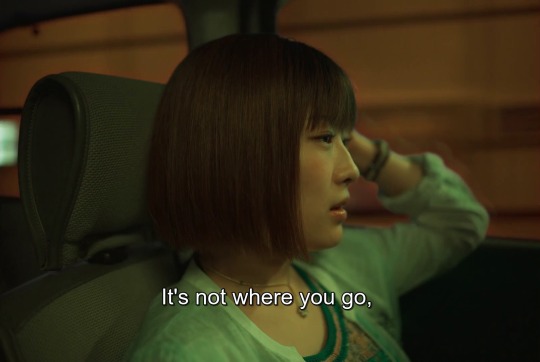

ボクたちはみんな大人になれなかった [We Couldn't Become Adults] (Yoshihiro Mori, 2021)
#drama film#passionate#Japan#Japanese movies#lifetime#ボクたちはみんな大人になれなかった#Yoshihiro Mori#Buddha#We Couldn't Become Adults#Mirai Moriyama#Sairi Ito#travel#Masahiro Higashide#SumireTakehiro Hira#revelation#voyage#Atsushi Shinohara#Moemi Katayama#Amane Okayama#gioia#Masanobu Takashima#relationships#2020s movies#romance#Far east cinema#memories#friendship#happiness#viaggio#aging
43 notes
·
View notes
Text
Danganronpa:Ransei's Tears
read it on the AO3 at https://ift.tt/eh0H1nG
by Spinnetossa_Shipper
After the great Ransei War, it is believed that peace has returned to the region. However, as the 38 Warlords and Junior Warlords suddenly vanish without a trace, peace seems unlikely. Waking up in an unknown environment, these warlords must now fight for their survival. What will it take for these closely bonded warriors to kill once more?...
(This is more of a Pokemon Conquest centric fanfic so you do not need to be a Danganronpa fan to understand this story)
(First Chapter is an authors note and not part of the story)
Words: 187, Chapters: 1/?, Language: English
Fandoms: Dangan Ronpa Series, Pokemon + Nobunaga no Yabou | Pokemon Conquest
Rating: Teen And Up Audiences
Warnings: Graphic Depictions Of Violence, Major Character Death
Categories: Multi
Characters: Shujinkou | Hero (Pokemon), Shujinkou | Heroine (Pokemon), Oda Oichi, Maeda Keiji, Fukushima Masanori, Ishida Mitsunari, Katou Kiyomasa, Toyotomi Hideyoshi, Kuroda Kanbei, Takenaka Hanbei, Mouri Motonari, Chousokabe Motochika, Tachibana Ginchiyo, Tachibana Muneshige, Imagawa Yoshimoto, Shimazu Yoshihiro, Uesugi Kenshin, Naoe Kanetsugu, Aya Gozen, Takeda Shingen, Sanada Yukimura, Kunoichi (Samurai Warriors), Houjou Ujiyasu, Narita Kaihime, Fuuma Kotarou, Nene | Toyotomi Yoshiko, Hattori Hanzou, Date Masamune, Saika Magoichi, Tokugawa Ieyasu, Honda Tadakatsu, Komatsuhime | Honda Inahime, Saitou Nouhime, Izumo no Okuni, Akechi Mitsuhide, Hosokawa Gracia, Mori Ranmaru (Historical RPF), Oda Nobunaga
Additional Tags: Crossover, Killing Game (Dangan Ronpa), Character Death, Original Character(s)
read it on the AO3 at https://ift.tt/eh0H1nG
0 notes
Photo

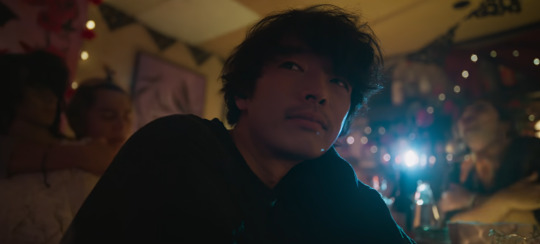
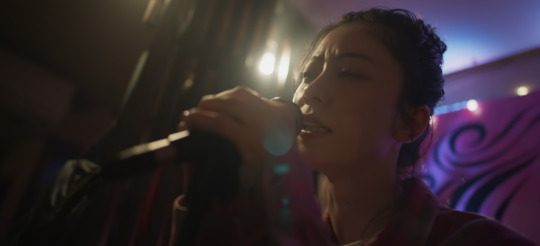


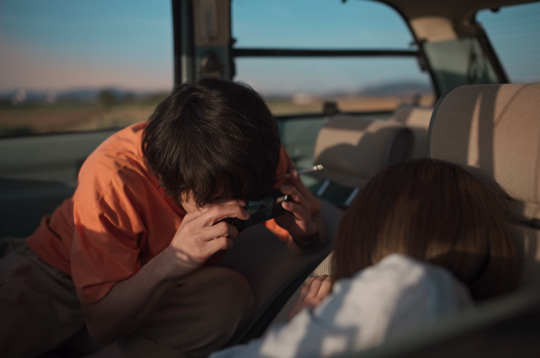
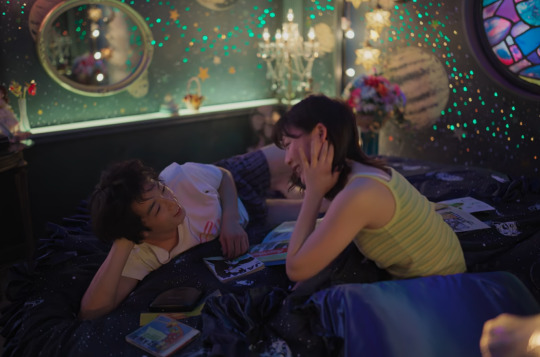
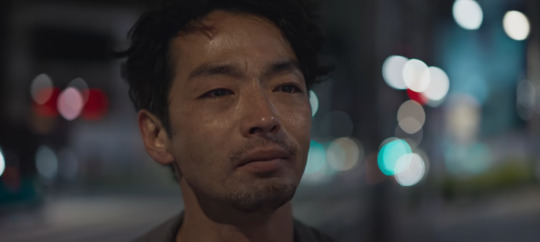


ボクたちはみんな大人になれなかった: We couldn’t become adults (2021). — dir. Yoshihiro Mori • dop: Akiyoshi Yoshida.
#ボクたちはみんな大人になれなかった#We couldn't become adults (2021)#Asian cinema#my screenshots#cinematography#Akiyoshi Yoshida#Yoshihiro Mori
15 notes
·
View notes
Text
We Couldn’t Become Adults (2021)












ボクたちはみんな大人になれなかった We Couldn’t Become Adults (2021) directed by Yoshihiro Mori cinematography by Akiyoshi Yoshida
#ボクたちはみんな大人になれなかった#yoshihiro mori#japanese movies#japanese cinema#japanese film#asian cinema#netflix#mirai moriyama#sairi ito#stills#we couldn’t become adults
67 notes
·
View notes
Text
Warriors Orochi: The Recollective Redux Part 4.1: Wu Story A
Here we go again with the Wu story!
Initial characters: Sun Ce, Lu Su, Han Dang, Hanzō Hattori, Ieyasu Tokugawa, Naotora Ii, Naomasa Ii
Chapter 1: Battle of Mt. Dingjun 定軍山の戦い
Orochi Army and Xu Huang Army vs. Resistance Army Allied characters: Sun Ce, Sun Quan, Ieyasu Tokugawa, Han Dang Third-party characters: Xu Huang, Yue Jin Enemy characters: Ma Chao, Ranmaru Mori, Yueying, Jiang Wei, Ma Dai, Zhang Bao
Unlocked characters: Zhou Yu, Ranmaru Mori
The officers of Wu were defeated by Orochi at Hefei and Dingtao. Many of their officers, including their leader, Sun Jian, were captured as prisoners-of-war. Sun Ce was then forced to join the Orochi Army and fight the Resistance Army, with his father’s life at threat. However, for every unit they suppress, one hostage will be freed.
Ma Chao banded together some scattered units and led them to Mt. Dingjun. Sun Ce was sent there to suppress this Resistance unit. Though he does not like the prospect of fighting for Orochi, he does so both to protect his family and friends and to test his skill on some worthy opponents.
In the aftermath, Ranmaru is captured by Sun Ce, but he lets him go. Confused at Sun Ce’s actions, Ranmaru decides to join him. Ma Chao escapes the battlefield and Zhou Yu is freed by Orochi.
Chapter 2: Battle of Changban 長坂の戦い
Orochi Army and Da Ji Army vs. Resistance Army Allied characters: Sun Ce, Zhou Yu, Ranmaru Mori, Naotora Ii Third-party characters: Da Ji (withdraws) Enemy characters: Lu Xun, Gan Ning, Zhu Ran, Motochika Chōsokabe, Ling Tong, Sakon Shima
Unlocked characters: Taishi Ci
Orochi orders Sun Ce to wipe out another Resistance unit in Changban. The officers in the unit included Lu Xun, Zhu Ran, Gan Ning and Ling Tong, all officers of Wu. This was a test devised by Da Ji to measure Sun Ce’s loyalty by having him fight against his former allies.
Naotora Ii will appear as an additional officer advancing to the centre of the battlefield. Motochika Chōsokabe will appear in the northwest of the battlefield.
Defeat all officers to win this battle. In the aftermath, Taishi Ci is released from imprisonment.
Chapter 3: Battle of Odani Castle 小谷城の戦い
Orochi Army and Sakon Shima Troop vs. Resistance Army Allied characters: Sun Ce, Zhou Yu, Lu Su, Han Dang, Naomasa Ii Third-party characters: Sakon Shima Enemy characters: Xingcai, Yoshihiro Shimazu, Ling Tong, Gan Ning, Toyohisa Shimazu
Unlocked characters: Lu Meng, Sakon Shima
Sun Ce was ordered to supress the Resistance again, this time at Odani Castle. They were led by Xingcai, with assistance from Gan Ning and Ling Tong, who had fled from Changban. Just as Sun Ce was about to set off, he receives a letter from Sakon, who he met at Changban. He has information concerning Sun Jian that he wants to give to Sun Ce at Odani Castle. However, when they arrive, Sakon has not arrived yet, so they decide to supress the Resistance.
Lu Su replaces Ranmaru Mori in this battle and he will take Zhou Yu’s line about stopping the enemy reinforcements. Toyohisa Shimazu replaces Zhang Bao as well (Zhang Bao will have been captured in Chapter 1), with his place in the Shimazu reinforcements taken by Toshihisa Shimazu.
In the aftermath, Lu Meng is released from imprisonment. Sakon tells Sun Ce that his father is being held at Ōsaka Castle. Sun Ce asks Sakon for his help to guide them there.
Chapter 4: Battle of Ōsaka Castle 大坂城の戦い
Coalition Army and Sun Jian Army vs. Orochi Army Allied characters: Sun Ce, Sakon Shima, Ranmaru Mori Third-party characters: Sun Jian Enemy characters: Cao Ren, Pang De, Yue Jin, Yu Jin, Deng Ai, Zhong Hui, Zhuge Dan, Chen Gong
With the information of his father’s whereabouts gained from Sakon, Sun Ce decided to defect from Orochi and rescue his father.
Yu Jin replaces Hao Zhao and Zhong Hui replaces Zang Ba in the main keep of Ōsaka Castle. Deng Ai replaces Hognose, Zhuge Dan replaces Boomslang and Chen Gong replaces Mamushi as you escape Ōsaka Castle.
To win the battle, Sun Ce and Sun Jian need to reach the escape point (which is basically where you started, but once the father and son are about to escape, more Orochi defence units confront them. Sun Jian offers to stand his ground to allow Sun Ce to escape.
Chapter 5: Battle of Sekigahara 関ヶ原の戦い
Coalition Army vs. Orochi Army Allied characters: Sun Ce, Zhou Yu, Taishi Ci, Naotora Ii, Han Dang, Lu Su, Naomasa Ii Enemy characters: Ina, Sun Shangxiang, Daqiao, Ding Feng, Sun Quan, Zhou Tai, Lianshi
Unlocked characters: Ina, Sun Shangxiang
The morale of the Wu Army was damaged after the failed rescue of Sun Jian. Sun Quan and Sun Shangxiang were obliged to continue their service to the Orochi Army. Sun Ce was declared a traitor, with his punishment tasked to Sun Quan. The three siblings meet at Sekigahara for a confronting showdown.
Naotora Ii and Lu Su appear in place of Zhu Zhi and Cheng Pu in this battle. Naomasa Ii will appear later in place of Tadayoshi Matsudaira when allied reinforcements arrive. Lianshi will appear in place of Zhuge Jin, who in turn will appear in place of Zhuge Ke (Luo).
In the aftermath, Ina tells Sun Shangxiang that Sun Ce is a good man who is concerned for his family. They decide to join Sun Ce’s army.
Chapter 6: Battle of Hefei 合肥の戦い
Coalition Army vs. Orochi Army Allied characters: Sun Ce, Lu Meng, Hanzō Hattori, Ina, Naomasa Ii, Naotora Ii Enemy characters: Sun Quan, Zhou Tai, Lianshi, Cao Ren, Keiji Maeda, Zhenji, Ding Feng, Lu Lingqi, Hisahide Matsunaga, Munenori Yagyū, Yoshitsugu Ōtani
Unlocked characters: Zhou Tai
Orochi sends Sun Quan to attack his brother once more at Hefei, supported by Cao Ren and Keiji Maeda.
On the Coalition Army side, Ina will appear in place of Han Dang, Naomasa Ii will appear in place of Naotaka Ii and Naotora Ii will appear in place of Tadaoki Naitō in the ambush attack.
On the Orochi Army side, Lianshi will appear in place of Sun Shao, Lu Lingqi will appear in place of Yue Jin, Hisahide Matsunaga will appear in place of Cao Zhang and Munenori Yagyū will appear in place of Hiroie Kikkawa.
In the aftermath, Zhou Tai helps Sun Quan escape before he reveals (via Lu Meng) that Sun Quan has been blackmailed by Orochi into fighting for him. Sun Ce asks Zhou Tai to join him.
Chapter 7: Battle of Komaki-Nagakute 小牧長久手の戦い
Coalition Army and Sun Jian Army vs. Orochi Army Allied characters: Sun Ce, Sun Shangxiang, Lu Su, Han Dang Third-party characters: Sun Jian, Sun Quan, Lianshi Enemy characters: Da Ji, Sima Yi, Dong Zhuo, Zhuge Dan, Sima Shi, Zhang Chunhua, Ding Feng (defects to Sun Jian after his rescue)
Unlocked characters: Sun Jian, Sun Quan, Lianshi, Ding Feng
Sun Quan returned to Orochi, aware that he would be punished for his repeated failures to subdue his brother’s rebellion. The news filtered through to Sun Ce that his father, brother and sister-in-law would soon be executed at Komaki-Nagakute, under the direction of Dong Zhuo and Da Ji. Sun Ce quickly assembles an army and sets off. With the help of Hanzō, Sun Jian, Sun Quan and Lianshi have escaped execution, but they are trapped within the enemy camp. Sun Ce and Sun Shangxiang will move to rescue their family, while the other officers act as decoy units.
Lu Su replaces Dong Xi as he heads north alongside Jiang Qin while Han Dang and Cheng Pu head to the centre. Lianshi will appear with Sun Jian and Sun Quan in the southwestern garrison.
Zhuge Dan appears in place of Zhang He, Sima Shi appears in place of Sima Zhao and Zhang Chunhua appears in place of Guo Huai in this battle.
In the aftermath, Ranmaru finally understands that Sun Ce and Sun Quan’s actions were done out of consideration for the future of Wu.
Chapter 8: Battle of Koshi Castle 古志城の戦い
Coalition Army vs. Orochi Army Allied characters: Sun Jian, Sun Ce, Sun Quan, Sun Shangxiang, Zhu Zhi Enemy characters: Orochi, Da Ji, Lu Bu, Dong Zhuo, Deng Ai, Zhong Hui, Diamondback
Some variations have been made to the Chapter 8 Koshi Castle battles. In each faction’s version, they will fight one of Orochi’s main generals with the exception of Da Ji and Lu Bu, who will appear in each version. In this version of the battle, that general will be Dong Zhuo (because of an event in the original where he traps Sun Shangxiang in the southeastern garrison).
In the southern cannon garrison, Deng Ai appears in place of Yellowbelly, who will appear later to fire the cannon again on allied units inside Koshi Castle upon entering the inner sanctum. Inside Koshi Castle, Zhong Hui and Diamondback will respectively defend the main gate and the inner gate.
Defeat Orochi to win the battle.
#dynasty warriors#samurai warriors#warriors orochi#warriors orochi z#warriors orochi: the recollective redux
0 notes
Photo


Boris: W (Sacred Bones, 2022)
Painting by Kotao Tomozawa Design by FangsAnalSatan
Wata photographed by Yoshihiro Mori.
7 notes
·
View notes